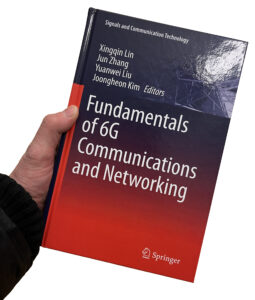Several 6G-related edited books have recently been published, which highlights the fact that the 6G-related research has now progressed for at least five years. Although the standardization is yet to begin, we know quite well which new technology components will be on the agenda. This does not mean that everything that is being researched will eventually be used—far from it—but we can be quite sure that 6G will build on a subset of them.

I have co-authored a chapter in the new book Fundamentals of 6G Communications and Networking, published by Springer and edited by Xingqin Lin, Jun Zhang, Yuanwei Liu, and Joongheon Kim. The book contains chapters about 6G visions and tutorials on new waveforms, coding and access schemes, integrated communication and sensing, reconfigurable intelligent surfaces, cell-free networks, non-terrestrial networks, semantic communication, and different aspects of AI.
My contribution was a chapter on Near-Field Beamforming and Multiplexing, written with Parisa Ramezani. We describe how previously negligible physical phenomena become essential when making the antenna arrays larger in future networks. These radiative near-field effects impact everything from pathloss modeling to the physical shapes of transmitted signals and the ability to spatially multiplex many user devices. If you are unfamiliar with these effects, I recommend reading our chapter. We summarize the technical insights and fundamentals from a few recent papers and tell the complete story around it. In a way, it is the detailed version of the following video tutorial:
What is the reason to write a book chapter?
The good thing about writing a book chapter, compared to a tutorial article for a scientific journal, is that you get much freedom to organize it in the way you find most pedagogical. You are typically invited to write a chapter based on your expertise and trusted in your ability to do so; thus, the review process is friendly and constructive.
The fact that your chapter is grouped together with those written by other experts could be a good way of attracting readers. However, one must be cautious because some publishers are particularly greedy when it comes to copyright: they might ban you from ever uploading a preprint to your homepage or arXiv. This happened to me with a chapter about energy-efficient communications in a book published by IET, with the result that it has probably only been read by a handful of people and has no citations. This is because few researchers and universities pay for access to the IET database, and even fewer buy printed books these days. In retrospect, it was clearly not worth the effort put into the writing process—we don’t even get money from book sales. This happened in 2019, but despite the push toward Open Science, there are other publishers that behave badly. Two years ago, I was asked to write a chapter for a book on reconfigurable intelligent surfaces under the same bad conditions, but this time, I was aware of the issue and declined.
Springer is one of the more reasonable open publishers, which allows you to share the preprint immediately and then share the final author version one year after publication. This is at least a step in the right direction.

Wish to read more articles in the future.
Incredible article that I have read about 6G
This is a fascinating glimpse into the advancements in 6G research! The chapter on Near-Field Beamforming and Multiplexing sounds particularly intriguing, especially with its focus on how larger antenna arrays will reshape network dynamics.
It’s great to see complex topics explained so comprehensively. Looking forward to exploring the book and understanding these groundbreaking concepts better. Thanks for sharing!